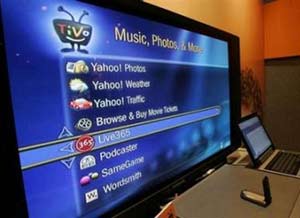It seems that at least once a day, you encounter a pop-up ad for some online video downloading service. From the television series “Desperate Housewives” to cool footage, it’s everywhere.
 |
|
Source: AP |
Are you excited about that? But does the Internet share your enthusiasm?
ISPs Cry Foul
The answer from Internet service providers (ISPs), phone, and cable companies is “No.” Small clips are fine, but TV-quality programs, especially high-definition ones, can completely choke the Internet.
Nowadays, most of our online activities are quick and fleeting, checking emails here and browsing a website there. But imagine if we were to watch streamed videos online just like we do on TV—at least a few hours at a time—the Internet would have to bear an enormous load.
Of course, the original infrastructure of the Internet simply cannot handle this load, and the cost to upgrade capacity to prevent such choking incidents is incredibly expensive.
To offset some of these costs, ISPs want to charge extra “fees” to content providers. Without paying these fees, there’s no guarantee that large video files will be delivered where they need to go.
Many people have reacted strongly against this plan, arguing that it would stifle creativity and is “unfair.” They want laws to ensure a “neutral” Internet, but the prospects seem very slim.
The crux of the issue lies in the question: What is the actual cost that ISPs incur to deliver a few hours of video clips on their networks each day?
Clearly, ISPs keep their cards very close to their chest, but there are ways for us to guess their hand.
Truth or Fiction
Let’s start with the numbers. According to research firm TeleGeography, a continuous 1 Mb/s connection into the backbone of the Internet in Atlanta costs ISPs between $10 and $20 per month. ISPs are responsible for “transporting” the data “flowing” from that connection to users.
One Mb/s doesn’t sound like much, but ISPs always multiply bandwidth when delivering to users. It is estimated that ISPs typically sell a bandwidth capacity 30 times greater so that end users can connect simultaneously to the Internet.
Thus, broadband can be understood similarly to traditional telephone services. The number of phone lines from a home to the local exchange is always greater than the number of lines going out from the exchange. If everyone picks up the phone at once, some calls will fail because there aren’t enough outgoing lines. However, this rarely happens, so the system continues to operate normally.
Business Model in Ruins
For broadband networks, a 1 Mb/s connection can serve 40 DSL accounts, each capable of a maximum speed of 768 kb/s, typical for a basic DSL connection. The cost to deliver data to each of these DSL users is only about 25 to 50 cents per user per month.
If these DSL accounts only use the Internet for web browsing, reading emails, or occasionally downloading files, nothing much happens. But if all 40 subscribers try to download the evening news simultaneously, there will definitely be a problem.
If the connection speed is 2 Gb/s, ISPs incur about $1. This is a small figure compared to the subscription fees of $25 to $47 per month they charge for DSL, but of course, they also have to pay for sales, technical support, maintenance, and a host of other unnamed costs.
If 40 users start downloading 5 TV-quality movies each month, excluding the cost of maintaining the DSL line, ISPs would lose up to $4.50 per month. Nevertheless, this is still not high enough to disrupt their current business model.
However, if users begin watching Internet TV for 8 hours a day, the costs incurred by ISPs would soar to $112 per month.
To cope with this “market crash,” BellSouth plans to “label” the types of data flowing across the network: which types are free and which will incur additional fees. Other options include charging content providers a fee, termed a “guarantee” for their content to ensure its delivery.
Meanwhile, opponents believe that allowing ISPs to charge fees also carries risks. “Who knows if they will use that fee to expand bandwidth?” a Google official stated.
Thien Y





















































